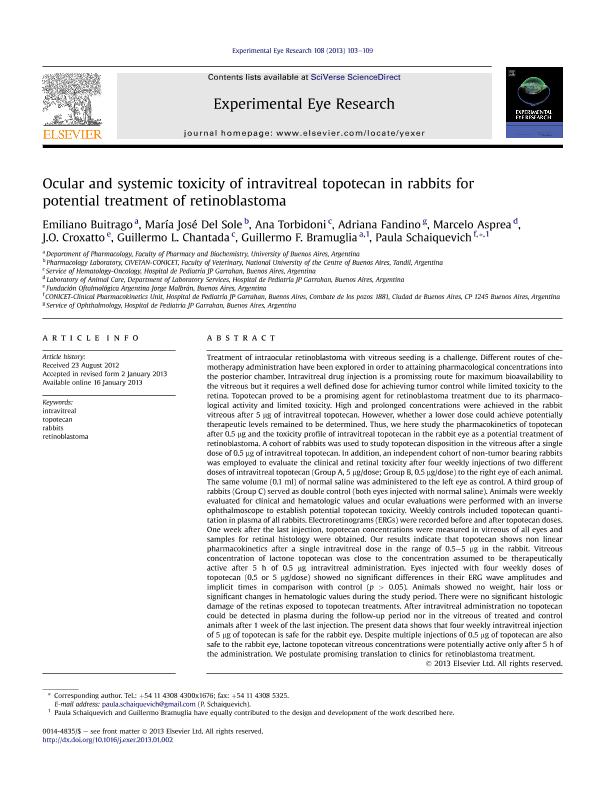Artículo
Ocular and systemic toxicity of intravitreal topotecan in rabbits for potential treatment of retinoblastoma
Buitagro, Emiliano; del Sole, Maria Jose ; Torbidoni, Ana Vanesa
; Torbidoni, Ana Vanesa ; Fandino, Adriana; Asprea, Marcelo; Croxatto, Juan Oscar
; Fandino, Adriana; Asprea, Marcelo; Croxatto, Juan Oscar ; Chantada, Guillermo; Bramuglia, Guillermo; Schaiquevich, Paula Susana
; Chantada, Guillermo; Bramuglia, Guillermo; Schaiquevich, Paula Susana
 ; Torbidoni, Ana Vanesa
; Torbidoni, Ana Vanesa ; Fandino, Adriana; Asprea, Marcelo; Croxatto, Juan Oscar
; Fandino, Adriana; Asprea, Marcelo; Croxatto, Juan Oscar ; Chantada, Guillermo; Bramuglia, Guillermo; Schaiquevich, Paula Susana
; Chantada, Guillermo; Bramuglia, Guillermo; Schaiquevich, Paula Susana
Fecha de publicación:
03/2013
Editorial:
Elsevier
Revista:
Experimental Eye Research
ISSN:
0014-4835
Idioma:
Inglés
Tipo de recurso:
Artículo publicado
Clasificación temática:
Resumen
Treatment of intraocular retinoblastoma with vitreous seeding is a challenge. Different routes of chemotherapy administration have been explored in order to attaining pharmacological concentrations into the posterior chamber. Intravitreal drug injection is a promissing route for maximum bioavailability to the vitreous but it requires a well defined dose for achieving tumor control while limited toxicity to the retina. Topotecan proved to be a promising agent for retinoblastoma treatment due to its pharmacological activity and limited toxicity. High and prolonged concentrations were achieved in the rabbit vitreous after 5 μg of intravitreal topotecan. However, whether a lower dose could achieve potentially therapeutic levels remained to be determined. Thus, we here study the pharmacokinetics of topotecan after 0.5 μg and the toxicity profile of intravitreal topotecan in the rabbit eye as a potential treatment of retinoblastoma. A cohort of rabbits was used to study topotecan disposition in the vitreous after a single dose of 0.5 μg of intravitreal topotecan. In addition, an independent cohort of non-tumor bearing rabbits was employed to evaluate the clinical and retinal toxicity after four weekly injections of two different doses of intravitreal topotecan (Group A, 5 μg/dose; Group B, 0.5 μg/dose) to the right eye of each animal. The same volume (0.1 ml) of normal saline was administered to the left eye as control. A third group of rabbits (Group C) served as double control (both eyes injected with normal saline). Animals were weekly evaluated for clinical and hematologic values and ocular evaluations were performed with an inverse ophthalmoscope to establish potential topotecan toxicity. Weekly controls included topotecan quantitation in plasma of all rabbits. Electroretinograms (ERGs) were recorded before and after topotecan doses. One week after the last injection, topotecan concentrations were measured in vitreous of all eyes and samples for retinal histology were obtained. Our results indicate that topotecan shows non linear pharmacokinetics after a single intravitreal dose in the range of 0.5–5 μg in the rabbit. Vitreous concentration of lactone topotecan was close to the concentration assumed to be therapeutically active after 5 h of 0.5 μg intravitreal administration. Eyes injected with four weekly doses of topotecan (0.5 or 5 μg/dose) showed no significant differences in their ERG wave amplitudes and implicit times in comparison with control (p > 0.05). Animals showed no weight, hair loss or significant changes in hematologic values during the study period. There were no significant histologic damage of the retinas exposed to topotecan treatments. After intravitreal administration no topotecan could be detected in plasma during the follow-up period nor in the vitreous of treated and control animals after 1 week of the last injection. The present data shows that four weekly intravitreal injection of 5 μg of topotecan is safe for the rabbit eye. Despite multiple injections of 0.5 μg of topotecan are also safe to the rabbit eye, lactone topotecan vitreous concentrations were potentially active only after 5 h of the administration. We postulate promising translation to clinics for retinoblastoma treatment.
Palabras clave:
Intravitreal
,
Topotecan
,
Rabbits
,
Retinoblastoma
Archivos asociados
Licencia
Identificadores
Colecciones
Articulos(CIVETAN)
Articulos de CENTRO DE INVESTIGACION VETERINARIA DE TANDIL
Articulos de CENTRO DE INVESTIGACION VETERINARIA DE TANDIL
Articulos(SEDE CENTRAL)
Articulos de SEDE CENTRAL
Articulos de SEDE CENTRAL
Citación
Buitagro, Emiliano; del Sole, Maria Jose; Torbidoni, Ana Vanesa; Fandino, Adriana; Asprea, Marcelo; et al.; Ocular and systemic toxicity of intravitreal topotecan in rabbits for potential treatment of retinoblastoma; Elsevier; Experimental Eye Research; 108; 3-2013; 103-109
Compartir
Altmétricas



